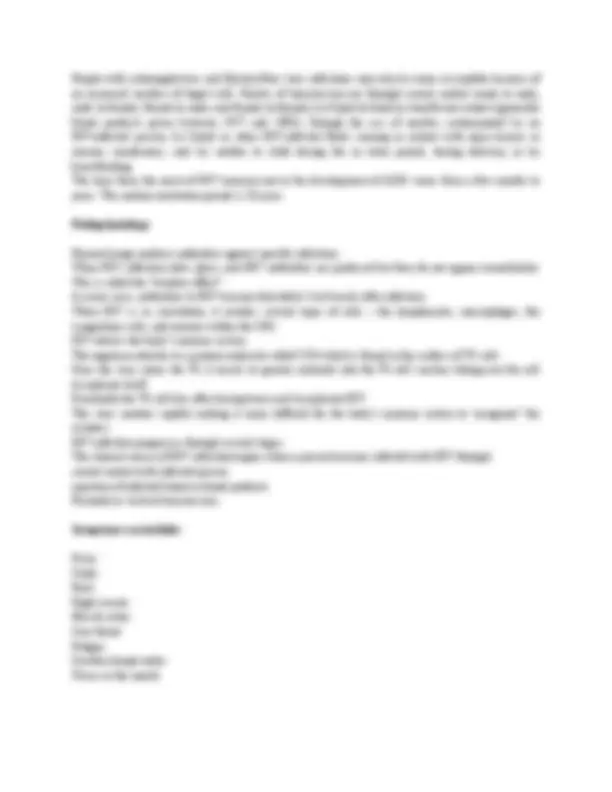



Study with the several resources on Docsity

Earn points by helping other students or get them with a premium plan


Prepare for your exams
Study with the several resources on Docsity

Earn points to download
Earn points by helping other students or get them with a premium plan
Community
Ask the community for help and clear up your study doubts
Discover the best universities in your country according to Docsity users
Free resources
Download our free guides on studying techniques, anxiety management strategies, and thesis advice from Docsity tutors
What HIV and AIDS are, how HIV weakens the immune system, how it attacks T-cells, and how it can lead to AIDS. It also describes the causes of HIV and AIDS, the difference between HIV-1 and HIV-2, and how susceptibility to infection is unclear. a detailed breakdown of the acronym HIV and AIDS, and explains that AIDS is a complex illness with a wide range of complications and symptoms.
Typology: Study notes
1 / 2

This page cannot be seen from the preview
Don't miss anything!


HIV is the human immuno deficiency virus. It is the virus that can lead to acquired immune deficiency syndrome, or AIDS. ● H – Human – This particular virus can only infect human beings. ● I – Immunodeficiency – HIV weakens your immune system by destroying important cells that fight disease and infection. A “deficient” immune system can’t protect you. ● V – Virus – A virus can only reproduce itself by taking over a cell in the body of its host. Human Immuno deficiency Virus is a lot like other viruses, including those that cause the “flu” or the common cold. But there is an important difference – over time, your immune system can clear most viruses out of your body. That isn’t the case with HIV – the human immune system can’t seem to get rid of it. Scientists are still trying to figure out why. We know that HIV can hide for long periods of time in the cells of your body and that it attacks a key part of your immune system – your T-cells or CD4 cells. Your body has to have these cells to fight infections and disease, but HIV invades them, uses them to make more copies of itself, and then destroys them. Over time, HIV can destroy so many of your CD4 cells that your body can’t fight infections and diseases anymore. When that happens, HIV infection can lead to AIDS To understand what AIDS is, let’s break it down: A – Acquired – AIDS is not something you inherit from your parents. You acquire AIDS after birth. I – Immuno – Your body’s immune system includes all the organs and cells that work to fight off infection or disease. D – Deficiency – You get AIDS when your immune system is “deficient,” or isn’t working the way it should. S – Syndrome – A syndrome is a collection of symptoms and signs of disease. AIDS is a syndrome, rather than a single disease, because it is a complex illness with a wide range of complications and symptoms. Acquired Immunodeficiency Syndrome is the final stage of HIV infection. People at this stage of HIV disease have badly damaged immune systems, which put them at risk for opportunistic infections (OIs). You will be diagnosed with AIDS if you have one or more specific OIs, certain cancers, or a very low number of CD4 cells. If you have AIDS, you will need medical intervention and treatment to prevent death. Causes HIV causes AIDS. Two HIV strains have been identified: HIV-1 and HIV-2. HIV-1 is the prototype virus and is responsible for most cases of AIDS in the United States. HIV-2 is found chiefly in West Africa, appears to be less easily transmitted, and has a longer incubation period. Susceptibility to infection is unclear. The presence of sexually transmitted infections (STIs) with open lesions, such as herpes and syphilis, may increase the patient’s susceptibility to viral entry.
People with cytomegalovirus and Epstein-Barr virus infections may also be more susceptible because of an increased number of target cells. Routes of transmission are through sexual contact (male to male, male to female, female to male, and female to female); by blood to blood or transfusion contact (generally blood products given between 1977 and 1985); through the use of needles contaminated by an HIV-infected person; by blood or other HIV-infected fluids coming in contact with open lesions or mucous membranes; and by mother to child during the in utero period, during delivery, or by breastfeeding. The time from the onset of HIV transmission to the development of AIDS varies from a few months to years. The median incubation period is 10 years. Pathophysiology Human beings produce antibodies against specific infections. When HIV infection takes place, anti-HIV antibodies are produced but they do not appear immediately. This is called the “window effect”. In some cases, antibodies to HIV become detectable 4 to 6 weeks after infection. When HIV is in circulation, it invades several types of cells – the lymphocytes, macrophages, the Langerhans cells, and neurons within the CNS. HIV attacks the body’s immune system. The organism attaches to a protein molecule called CD4 which is found in the surface of T4 cells. Once the virus enters the T4, it inserts its genetic materials into the T4 cell’s nucleus taking over the cell to replicate itself. Eventually the T4 cell dies after having been used to replicate HIV. The virus mutates rapidly making it more difficult for the body’s immune system to ‘recognize” the invaders. HIV infection progresses through several stages. The clinical course of HIV infection begins when a person becomes infected with HIV through: sexual contact with infected person injection of infected blood or blood products Perinatal or vertical transmission. Symptoms can include: Fever Chills Rash Night sweats Muscle aches Sore throat Fatigue Swollen lymph nodes Ulcers in the mouth